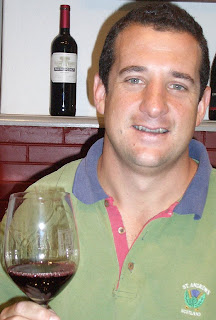 Scones are a Sunday treat here at Pinotage Towers. And what better topping than Pinotage jam?
Scones are a Sunday treat here at Pinotage Towers. And what better topping than Pinotage jam?I find it strange that grape jam is not more common. I am not aware of any being available in the UK. In South Africa you can buy Hanepoot jam, made from those large golden intensely sweet Muscat grapes used for making dessert wines.
Ripe Pinotage grapes are also quite sweet, and this jam comes from Beyerskloof Winery. Owner Beyers Truter has been incorporating Pinotage in many foods, sausages, ice-cream, yoghurts, meat sauces etc. See Red Leaf and Green Pinotage.

Unfortunately Pinotage jam is currently available only from the winery, but scones are easy and quick to make.
My scone recipe takes about 20 minutes to make and 20-25 minutes to cook
Ingredients
225g/8oz self raising flour
Pinch of salt
55g/2oz butter
Handful of sultanas
150ml/5fl oz milk
Method
1. Heat the oven to 200C/400F/Gas 6. Lightly grease a baking sheet.
2. Mix together the flour and salt and rub in the butter to get a bread crumb-like texture.
3. Sprinkle in the sultanas and stir them through, there should be plenty so add more if you want as they are the only sweetening* in the scones.
4. Mix in milk to get a soft dough
5. Turn on to a floured board and knead for a few minutes
6. Gently roll out to 2.5cm/1in thick – making them too thin is the biggest cause of disappointment.
7. Use a 5cm/2in cutter to stamp out rounds and place on a baking sheet. Knead remaining dough, roll out and stamp out more scones till all used. Cutting the edges helps the dough rise.
8. . Bake for 20-25 minutes until well risen and top is firm.
9. Place on a wire rack and serve with butter and good jam and cream to taste.
Eat while hot. They also freeze well; defrost before use and warm
*With the sultanas and sweet jam topping I think it is totally unnecessary to also add sugar to the scone
(Note: Scone is pronounced skoan (to rhyme with loan) or skon (to rhyme with ‘on’ – in Pinotage Towers those from the north say skon and those from the south say skoan. Thus both are correct.)

























